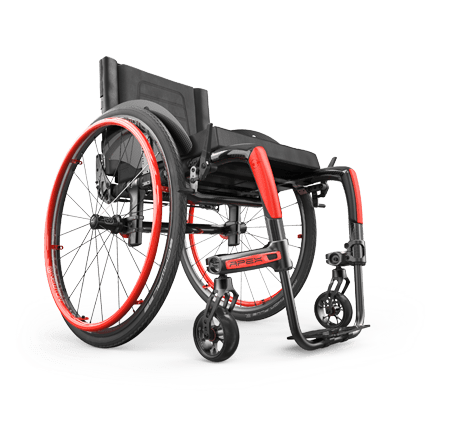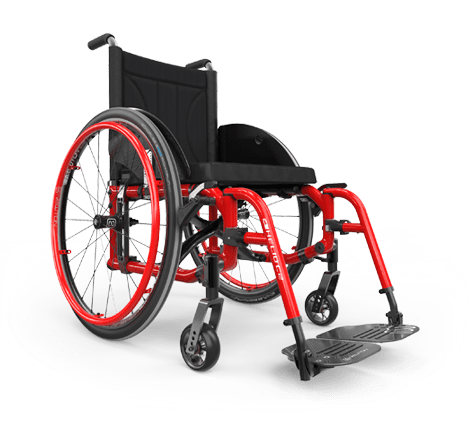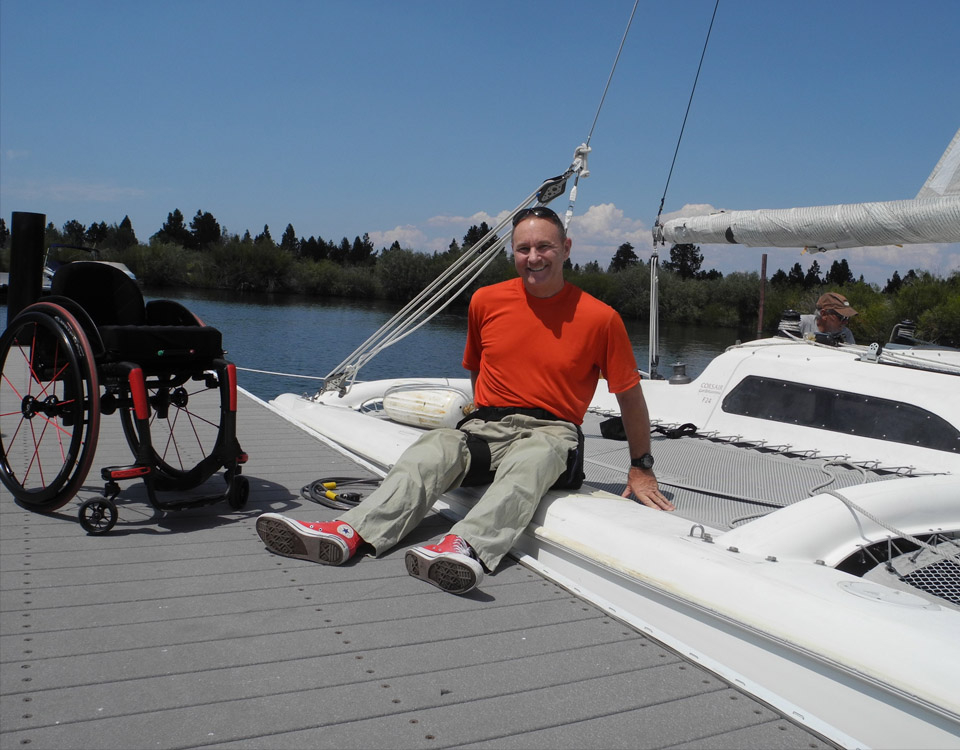(If you haven't, make sure to also read Part II & Part III of "Tips I've Learned in 36 Years as a Wheeler" Series by Bob Vogel).
Here are some important basics that I’ve learned about fit, front end angle and center of gravity, gleaned from 36 years of fine-tuning my chair setup as well as three decades of experience in the DME industry helping others choose and set up their chairs.
Fit
In my experience, a wheelchair should fit like a prosthesis, because that is what it is, a mobility prosthesis for your butt. A snug, properly fitting chair becomes an extension of your body, responding to the slightest input or movement. The two main areas of fit I will focus on are seat depth and width. Of the two, seat depth is the easiest to measure—I find that optimal seat depth is when the front seat upholstery (or seat pan) ends about two inches behind the bend at back of my knees (back of my calves). This provides good support for my thighs—which helps off-load pressure on the ischial tuberosity’s (butt bones) yet leaves space so the back of my calves do not touch the seat which can cause skin breakdown.
Seat Width
Seat width arguably the trickiest part of proper fit and the most vital. It should be snug for several reasons. A snug seat width allows your arms to be closer to your body which creates an optimal arm and shoulder angle for efficient performance when pushing your chair, and since the average wheelchair user pushes their handrims 2000–3000 times a day, it becomes apparent that proper seat width can help reduce shoulder strain; also, a chair that is measured as a snug fit will provide the smallest, lightest frame for your size, which will make it easier to navigate narrow areas and easier for car transfers.
I learned about incorrect chair width the hard way, when ordering my first chair during inpatient rehab. Experienced wheeling peers had advised me to order the narrowest chair possible—this became a point of contention when my therapist wanted to prescribe a 16″ wide chair which left a significant amount of space on each side of my hip. Eventually I gave in, and although the cool, red 16″ active lightweight chair was a huge improvement over my hospital chair, several years later I learned just how oversized it was for me. This happened when I got my next chair, which was a perfect fit at 14″ wide. It instantly felt more a part of me and within a few minutes of pushing and turning I realized how inefficient and flopping around I was my pushing the chair that was too wide for me. Three decades and a few extra pounds later, I’m still pushing a 14″ width chair.
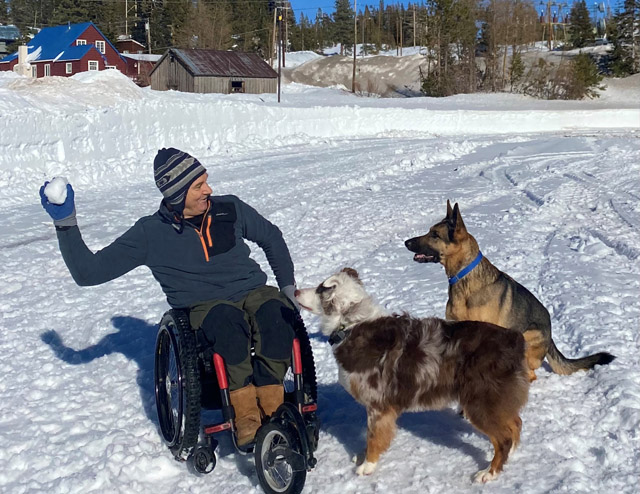
Bob Vogel in his 14'' width Apex Carbon - Playing fetch with his dogs Nikko and Killy.
For optimal fit in seat width, I’m a fan of rigid side guards, they protect my clothing and keep me centered in my chair. I prefer my chair width to be snug enough that I can slide the fingers of one hand in between my hip and the side guard of my chair and the fit is snug, but I can comfortably leave my fingers there. This is comfortable all summer and still leaves enough room for full-winter ski clothing. An important tip when making any changes in chair setup including width is to do a mirror-skin-check for red areas within the first 30–60 minutes after a change.
Front End Angle
Assuming you have normal range of motion in your knees, front end angle is a balance between a sharp angle, shorter front end that is able to turn in tighter spaces, and a mellower angle front end that is more stable but longer.
Front Angle 101
Standard rigid-frame wheelchair front end angles range from 90 degrees, which is straight down, to 70 degrees, in 5-degree increments—the lower the degree, the further out in front the footrest is. Although the difference in overall frame length from 70 degrees to 90 degrees is only 2.81″, it makes a huge difference in forward stability and performance, Learn more about Front Frame Angle here. To boil it down, a 90-degree front end makes a very short chair that can turn in extremely tight places but is also very front end tippy—so much so that leaning forward to pick something up, or a caster hitting a crack or pebble is likely to cause a forward tumble out of the chair. On the other end, a 70-degree frame is extremely stable, but is longer and not as nimble in tight spaces and/or quick turns.
My Experience with Various Front-End Angles
The front-end angle of my original chair was 75 degrees, considered a “tight” angle in 1985, it created an extremely stable front end that didn’t tip, and the mellow angle made it easier to master my early attempts at floor-to-chair transfers.
The front-end angle of my chairs got progressively sharper with each one, until I arrived at an 85-degree front end which “appears” to be straight down (90 degrees). In my experience, the 85-degree angle enabled quick turning as well as maneuvering in tight spaces but was so tight that leaning too far forward to pick something up, or a front caster hitting the occasional large pebble or sidewalk crack would result in a forward tumble—something that was no big deal in my younger days of strong leg bones, and young, muscled shoulders that enabled easy ground-to-chair transfers. A good friend of mine had the same make and model of chair but with a 90-degree front end, an angle so sharp that if he needed to pick something up off the ground he had to do it from the side of the chair as leaning forward would result in a tumble. Another friend of ours, who lives in the mountains had his chair set up at 75 degrees for stability on hills and hiking trails. On the other hand, when I would hop in his chair, my perception was that my legs were sticking way out in front of me, it felt weird for me, but for him the 75-degree angle works perfectly, and my chair felt weird to him.
Unfortunately, the years have taken their toll on my shoulders and floor to chair transfers are still doable, but a challenge. And like the average person with a spinal cord injury, my legs have developed severe osteoporosis (Read: Osteoporosis Update: Avoiding the Breaks - from New Mobility Magazine), and fracture all too easily. Something I learned in 2008 when a minor forward tumble out of my chair, while playing fetch with my dog, resulted in a femur fracture. When I ordered my Apex Carbon in 2017, I decided to change an 85-degree front end angle to a more mellow 80 degrees. It’s great! The chair “feels” just as tight and maneuverable as previous chairs with an 85-degree front end, but much is more stable, in the 5-years I’ve had this chair I have never taken a forward tumble! Hence in my “survey of one” 80 degrees is a great balance of stability and performance.
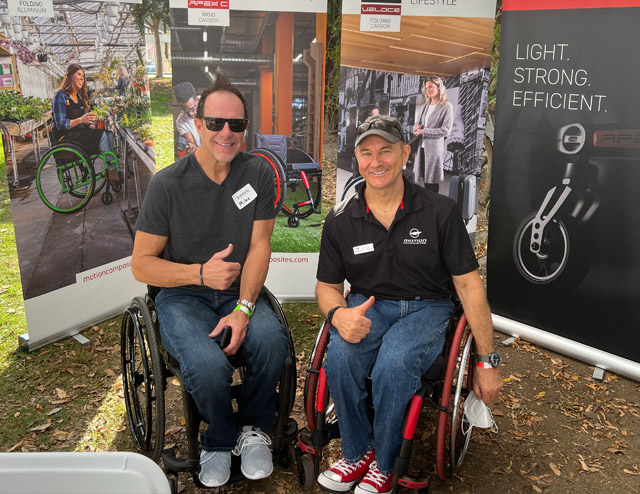
Bob Vogel (right) at the Adaptive Sports Festival 2021 with the Triumph Foundation.
Center of Gravity
Center of gravity (COG)—how far forward or back your rear wheels are—is another wheelchair setup that is a matter of balance, and will be unique to a wheeler’s strength, and wheelchair skills. Ideally, you want to move the rear wheels forward enough for optimum arm position while pushing, Learn more about Rear Wheels position here. In general, the more you move COG forward the more agile the chair becomes, as in quick, snappy turns. Drawbacks as a chair approach the “too tippy point” include tougher to get forward enough for balance when climbing steep hills. And there is a point when COG becomes too tippy; case in point, you wake up on the classroom floor, on your back, still in your chair, as classmates stare at you and you start to realize you dozed off in the middle of a college math class—something I “might have” discovered the hard way.
My Center of Gravity Journey
Like many wheelers, my first chair started out with anti-tippers and the center of gravity was set all the way back which made the chair very stable, but extremely sluggish and slow in turning performance. As my strength and wheelie skills improved, I started to move my center of gravity forward bit by bit. Over time I’d moved my COG so far forward that I could pop my front casters over pebbles and sidewalk cracks without touching my push rims, just a bit of body English, which was cool, until the classroom floor incident. The incident induced me to try to find my “sweet spot” which, for me, is having my axels directly under my hands with my arms relaxed at my side which is tippy enough to pop my casters over objects, albeit with a lot of body English, and yet the COG is far enough back that I can relax, and even nod off and not tip backwards. For others, this is COG will be “too tippy”, case in point my friend with the mountain chair setup has his COG setback quite a bit more than mine as he is frequently pushing up steep hills and trails.
My primary piece of advice for finding the ideal COG for you is to take it slow and make very small adjustments—no more than ½'' at a time—until you find the sweet spot that works for you.




